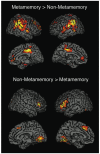Neural correlates of metamemory: a comparison of feeling-of-knowing and retrospective confidence judgments
- PMID: 18823230
- PMCID: PMC2709699
- DOI: 10.1162/jocn.2009.21123
Neural correlates of metamemory: a comparison of feeling-of-knowing and retrospective confidence judgments
Abstract
Metamemory refers to knowledge and monitoring of one's own memory. Metamemory monitoring can be done prospectively with respect to subsequent memory retrieval or retrospectively with respect to previous memory retrieval. In this study, we used fMRI to compare neural activity during prospective feeling-of-knowing and retrospective confidence tasks in order to examine common and distinct mechanisms supporting multiple forms of metamemory monitoring. Both metamemory tasks, compared to non-metamemory tasks, were associated with greater activity in medial prefrontal, medial parietal, and lateral parietal regions, which have previously been implicated in internally directed cognition. Furthermore, compared to non-metamemory tasks, metamemory tasks were associated with less activity in occipital regions, and in lateral inferior frontal and dorsal medial prefrontal regions, which have previously shown involvement in visual processing and stimulus-oriented attention, respectively. Thus, neural activity related to metamemory is characterized by both a shift toward internally directed cognition and away from externally directed cognition. Several regions demonstrated differences in neural activity between feeling-of-knowing and confidence tasks, including fusiform, medial temporal lobe, and medial parietal regions; furthermore, these regions also showed interaction effects between task and the subjective metamemory rating, suggesting that they are sensitive to the information monitored in each particular task. These findings demonstrate both common and distinct neural mechanisms supporting metamemory processes and also serve to elucidate the functional roles of previously characterized brain networks.
Figures





References
-
- Belli RF, Lindsay DS, Gales MS, McCarthy TT. Memory impairment and source misattribution in postevent misinformation experiments with short retention intervals. Mem Cognit. 1994;22(1):40–54. - PubMed
-
- Botvinick M. Conflict monitoring and decision making: reconciling two perspectives on anterior cingulate function. Cogn Affect Behav Neurosci. in press. - PubMed
-
- Bradfield AL, Wells GL, Olson EA. The damaging effect of confirming feedback on the relation between eyewitness certainty and identification accuracy. J Appl Psychol. 2002;87(1):112–120. - PubMed
-
- Brett M, Anton J, Valabregue R, Poline J. Region of interest analysis using an SPM toolbox; Paper presented at the 8th International Conference on Functional Mapping of the Human Brain; Sendai, Japan. 2002, June 2-6.
-
- Buckner RL, Andrews-Hanna JR, Schacter DL. The Brain's Default Network: Anatomy, Function, and Relevance to Disease. Ann N Y Acad Sci. 2008;1124:1–38. - PubMed
Publication types
MeSH terms
Substances
Grants and funding
LinkOut - more resources
Full Text Sources

